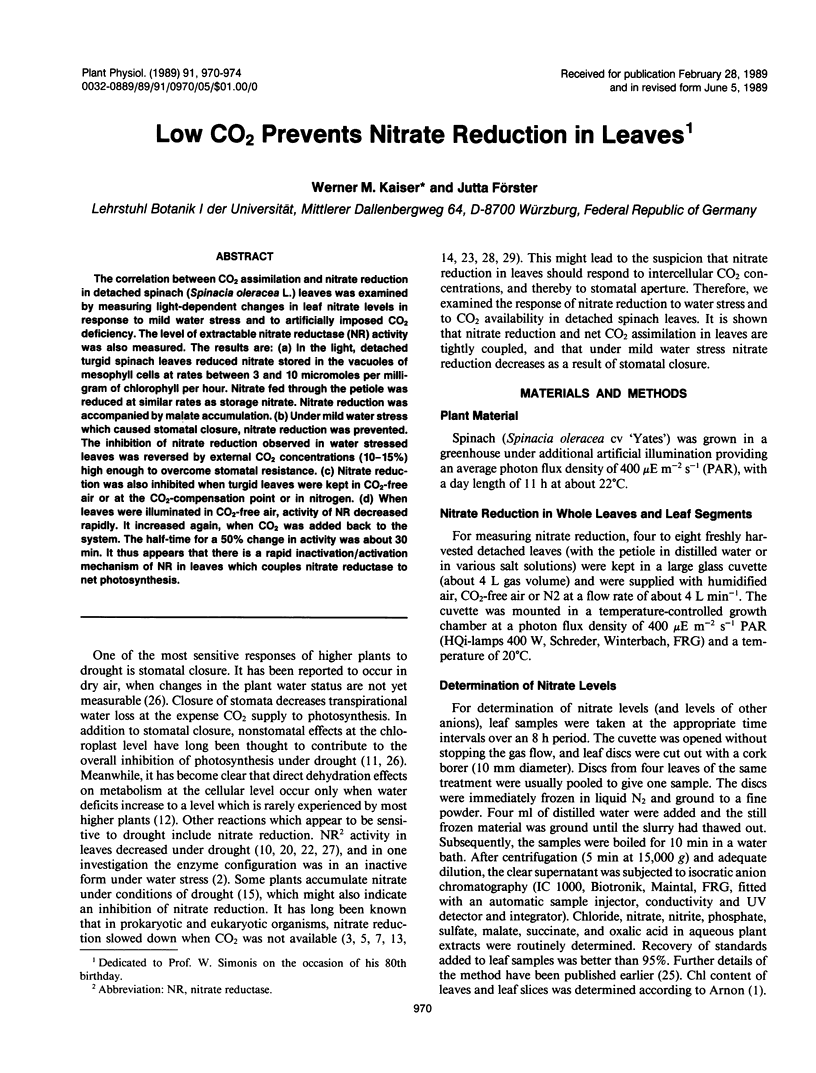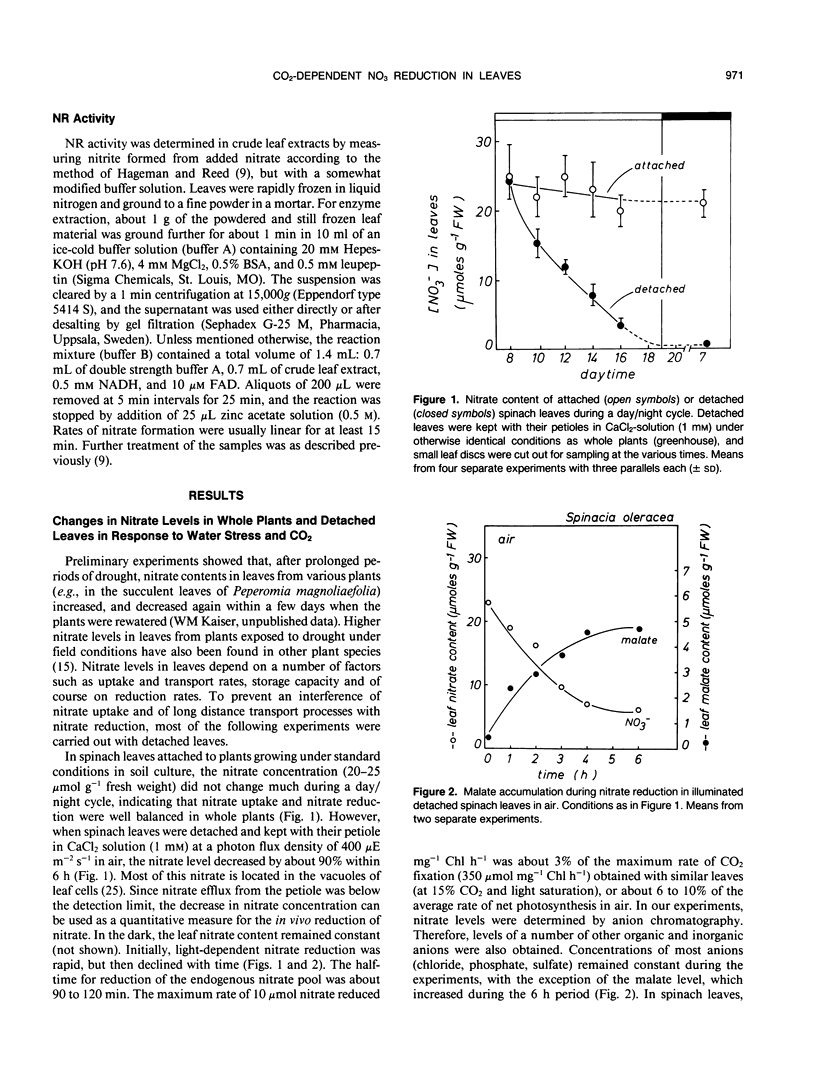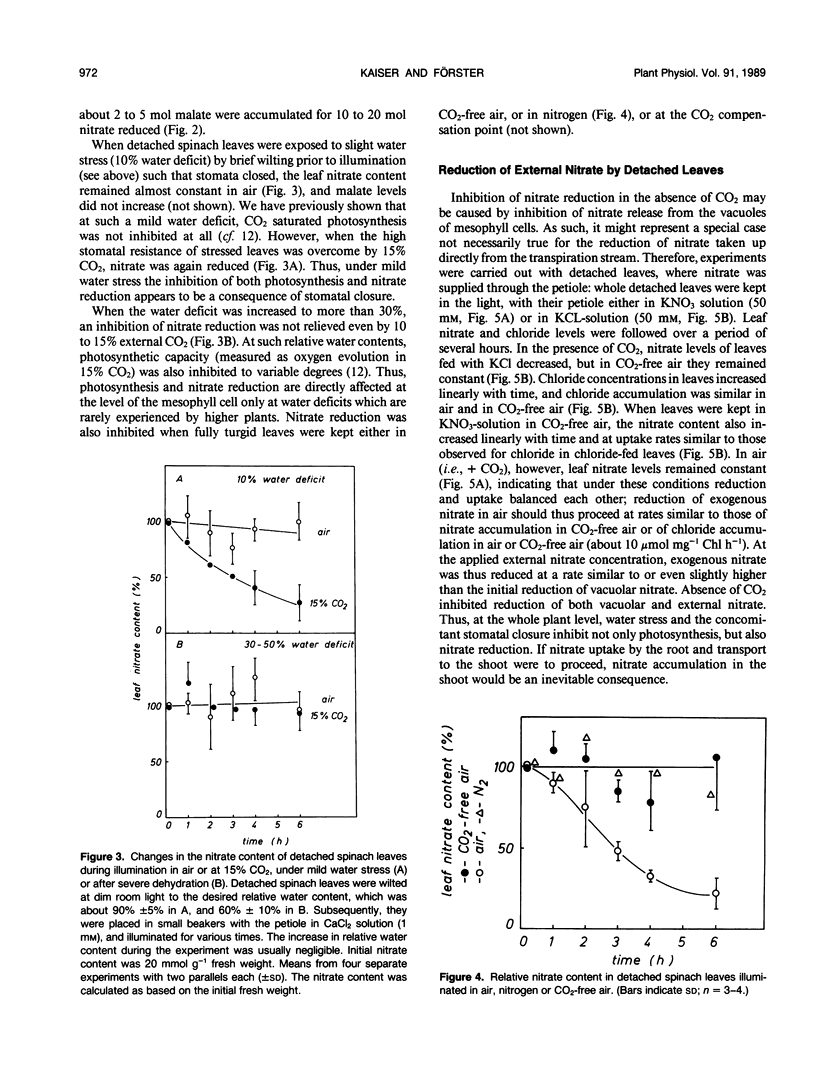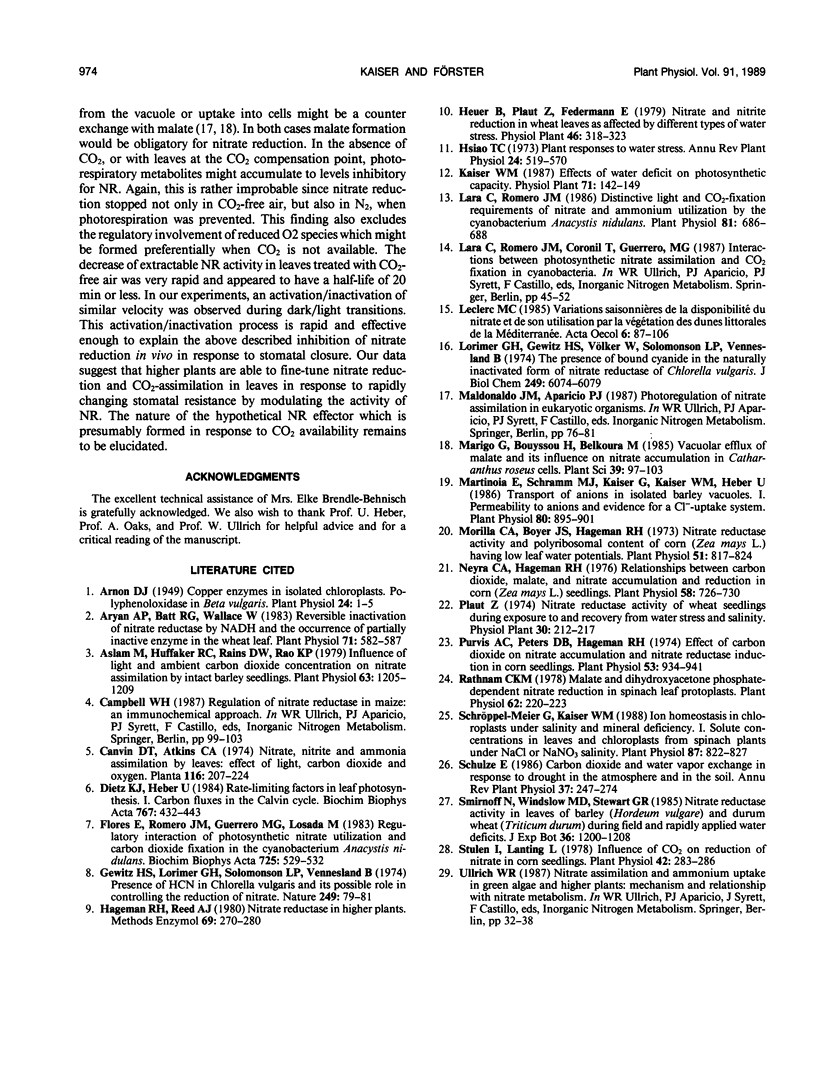Abstract
The correlation between CO2 assimilation and nitrate reduction in detached spinach (Spinacia oleracea L.) leaves was examined by measuring light-dependent changes in leaf nitrate levels in response to mild water stress and to artificially imposed CO2 deficiency. The level of extractable nitrate reductase (NR) activity was also measured. The results are: (a) In the light, detached turgid spinach leaves reduced nitrate stored in the vacuoles of mesophyll cells at rates between 3 and 10 micromoles per milligram of chlorophyll per hour. Nitrate fed through the petiole was reduced at similar rates as storage nitrate. Nitrate reduction was accompanied by malate accumulation. (b) Under mild water stress which caused stomatal closure, nitrate reduction was prevented. The inhibition of nitrate reduction observed in water stressed leaves was reversed by external CO2 concentrations (10-15%) high enough to overcome stomatal resistance. (c) Nitrate reduction was also inhibited when turgid leaves were kept in CO2-free air or at the CO2-compensation point or in nitrogen. (d) When leaves were illuminated in CO2-free air, activity of NR decreased rapidly. It increased again, when CO2 was added back to the system. The half-time for a 50% change in activity was about 30 min. It thus appears that there is a rapid inactivation/activation mechanism of NR in leaves which couples nitrate reductase to net photosynthesis.
Full text
PDF




Selected References
These references are in PubMed. This may not be the complete list of references from this article.
- Arnon D. I. COPPER ENZYMES IN ISOLATED CHLOROPLASTS. POLYPHENOLOXIDASE IN BETA VULGARIS. Plant Physiol. 1949 Jan;24(1):1–15. doi: 10.1104/pp.24.1.1. [DOI] [PMC free article] [PubMed] [Google Scholar]
- Aryan A. P., Batt R. G., Wallace W. Reversible Inactivation of Nitrate Reductase by NADH and the Occurrence of Partially Inactive Enzyme in the Wheat Leaf. Plant Physiol. 1983 Mar;71(3):582–587. doi: 10.1104/pp.71.3.582. [DOI] [PMC free article] [PubMed] [Google Scholar]
- Aslam M., Huffaker R. C., Rains D. W., Rao K. P. Influence of light and ambient carbon dioxide concentration on nitrate assimilation by intact barley seedlings. Plant Physiol. 1979 Jun;63(6):1205–1209. doi: 10.1104/pp.63.6.1205. [DOI] [PMC free article] [PubMed] [Google Scholar]
- Gewitz H. S., Lorimer G. H., Solomonson L. P., Vennesland B. Presence of HCN in chlorella vulgaris and its possible role in controlling the reduction of nitrate. Nature. 1974 May 3;249(452):79–81. doi: 10.1038/249079a0. [DOI] [PubMed] [Google Scholar]
- Lara C., Romero J. M. Distinctive Light and CO(2)-Fixation Requirements of Nitrate and Ammonium Utilization by the Cyanobacterium Anacystis nidulans. Plant Physiol. 1986 Jun;81(2):686–688. doi: 10.1104/pp.81.2.686. [DOI] [PMC free article] [PubMed] [Google Scholar]
- Lorimer G. H., Gewitz H. S., Völker W., Solomonson L. P. The presence of bound cyanide in the naturally inactivated form of nitrate reductase of Chlorella vulgaris. J Biol Chem. 1974 Oct 10;249(19):6074–6079. [PubMed] [Google Scholar]
- Martinoia E., Schramm M. J., Kaiser G., Kaiser W. M., Heber U. Transport of anions in isolated barley vacuoles : I. Permeability to anions and evidence for a cl-uptake system. Plant Physiol. 1986 Apr;80(4):895–901. doi: 10.1104/pp.80.4.895. [DOI] [PMC free article] [PubMed] [Google Scholar]
- Morilla C. A., Boyer J. S., Hageman R. H. Nitrate Reductase Activity and Polyribosomal Content of Corn (Zea mays L.) Having Low Leaf Water Potentials. Plant Physiol. 1973 May;51(5):817–824. doi: 10.1104/pp.51.5.817. [DOI] [PMC free article] [PubMed] [Google Scholar]
- Neyra C. A., Hageman R. H. Relationships between Carbon Dioxide, Malate, and Nitrate Accumulation and Reduction in Corn (Zea mays L.) Seedlings. Plant Physiol. 1976 Dec;58(6):726–730. doi: 10.1104/pp.58.6.726. [DOI] [PMC free article] [PubMed] [Google Scholar]
- Purvis A. C., Peters D. B., Hageman R. H. Effect of carbon dioxide on nitrate accumulation and nitrate reductase induction in corn seedlings. Plant Physiol. 1974 Jun;53(6):934–941. doi: 10.1104/pp.53.6.934. [DOI] [PMC free article] [PubMed] [Google Scholar]
- Rathnam C. K. Malate and Dihydroxyacetone Phosphate-dependent Nitrate Reduction in Spinach Leaf Protoplasts. Plant Physiol. 1978 Aug;62(2):220–223. doi: 10.1104/pp.62.2.220. [DOI] [PMC free article] [PubMed] [Google Scholar]
- Schröppel-Meier G., Kaiser W. M. Ion Homeostasis in Chloroplasts under Salinity and Mineral Deficiency : I. Solute Concentrations in Leaves and Chloroplasts from Spinach Plants under NaCl or NaNO(3) Salinity. Plant Physiol. 1988 Aug;87(4):822–827. doi: 10.1104/pp.87.4.822. [DOI] [PMC free article] [PubMed] [Google Scholar]


